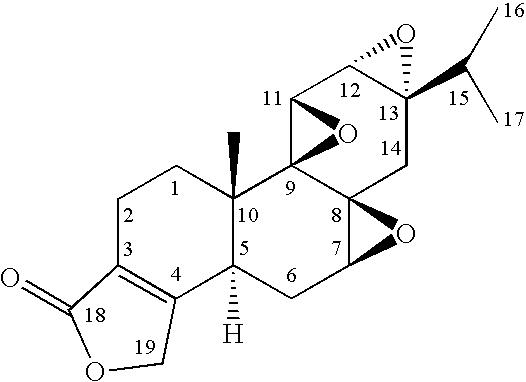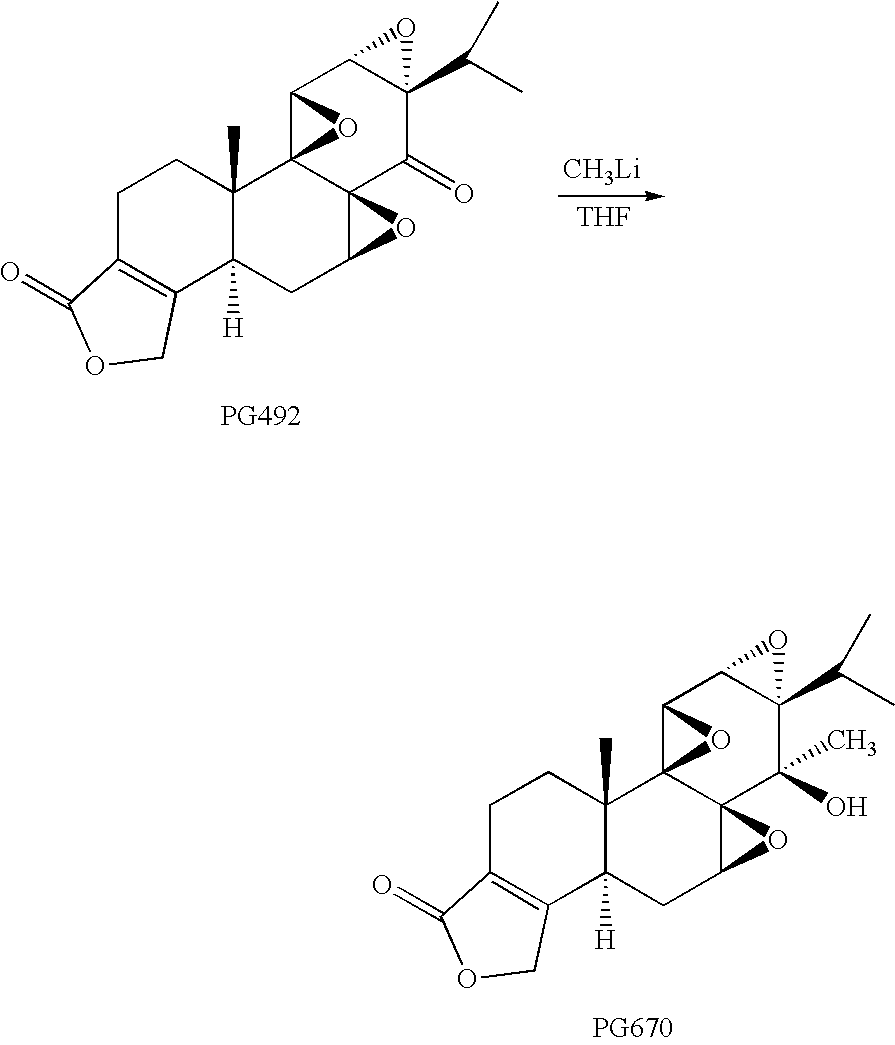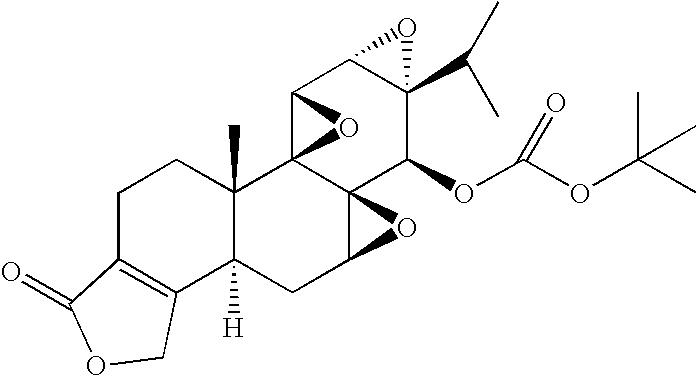Method for Treatment of Inflammatory Disorders Using Triptolide Compounds
- Summary
- Abstract
- Description
- Claims
- Application Information
AI Technical Summary
Benefits of technology
Problems solved by technology
Method used
Image
Examples
example 1
Preparation of 14-C-methyltriptolide (PG670)
[0058]
[0059] To a solution of triptonide (designated PG492) (60 mg, 0.17 mmol) in THF (5 ml) at −78° C. was added 0.45 ml of methyl lithium (1.4 M solution in ethyl ether, 0.63 mmol, 3.7 eq) under N2. The solution was stirred at −78° C. for 2 hrs 45 mins and then at room temperature for 2 hrs, at which time the starting material had disappeared on TLC. Acetic acid (1 ml) was slowly added. The solution was then concentrated under vacuum. The crude product was dissolved in dichloromethane (3 ml) and passed through a pad of silica gel, which was then washed with 5% methanol in ethyl acetate (80 ml). After removal of solvent, 78 mg of crude product was obtained. This was dissolved in acetonitrile (0.6 ml) and filtered. The product mixture was separated on HPLC, using a 10×250 mm column of Econosil C18 and a guard column cartridge (7.5×4.6 mm) of Alltima C18, both from Alltech, with mobile phase CH3CN / H2O 40 / 60 with a flow rate of 2.0 ml / min. ...
example 2
Synthesis of Triptolide 14-tert-Butyl Carbonate (PG695)
[0060]
[0061] To a solution of triptolide (108.1 mg, 0.30 mmol, 1.0 eq) and 4-DMAP (367.0 mg, 3.0 mmol, 10.0 eq) in dichloromethane (15 ml) was added with stirring di-tert-butyl dicarbonate (393.0 mg 1.80 mmol, 6.0 eq) at room temperature under nitrogen. After 48 hours of stirring at room temperature, methyl alcohol (1.0 ml) was added. The reaction mixture was concentrated under vacuum and the crude product was purified via preparative TLC (EtOAc / hexanes / MeOH 1:1:0.1) to give 131.3 mg (95.1%) of product.
example 3
Preparation of 14-deoxy-14α-fluoro triptolide
[0062]
[0063] To a solution of PG490 (triptolide, 17.3 mg, 0.048 mmol) in dichloromethane (1.0 ml) at 0° C. was added (diethylamino)sulfur trifluoride (DAST, 100 μl, 0.763 mmol) under N2. The reaction mixture was stirred at 0° C. for 2 hrs, and saturated NaHCO3 solution (0.8 ml) was then added. The reaction mixture was extracted with 3×2 ml of dichloromethane. The combined organic layer was dried over anhydrous Na2SO4 and concentrated under vacuum. The product (PG763) was obtained in quantitative yield.
PUM
| Property | Measurement | Unit |
|---|---|---|
| Density | aaaaa | aaaaa |
| Density | aaaaa | aaaaa |
| Density | aaaaa | aaaaa |
Abstract
Description
Claims
Application Information
 Login to View More
Login to View More - R&D
- Intellectual Property
- Life Sciences
- Materials
- Tech Scout
- Unparalleled Data Quality
- Higher Quality Content
- 60% Fewer Hallucinations
Browse by: Latest US Patents, China's latest patents, Technical Efficacy Thesaurus, Application Domain, Technology Topic, Popular Technical Reports.
© 2025 PatSnap. All rights reserved.Legal|Privacy policy|Modern Slavery Act Transparency Statement|Sitemap|About US| Contact US: help@patsnap.com



